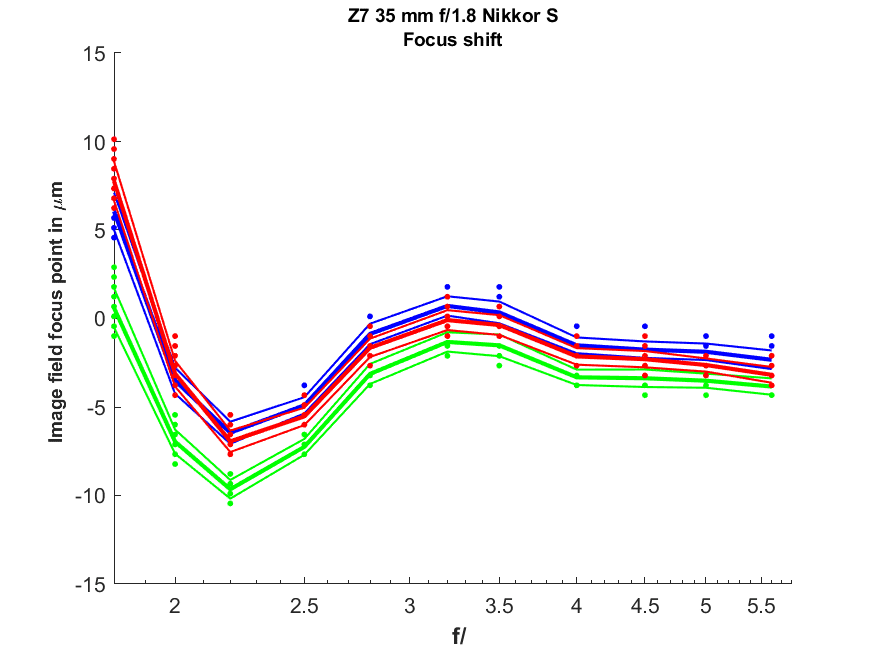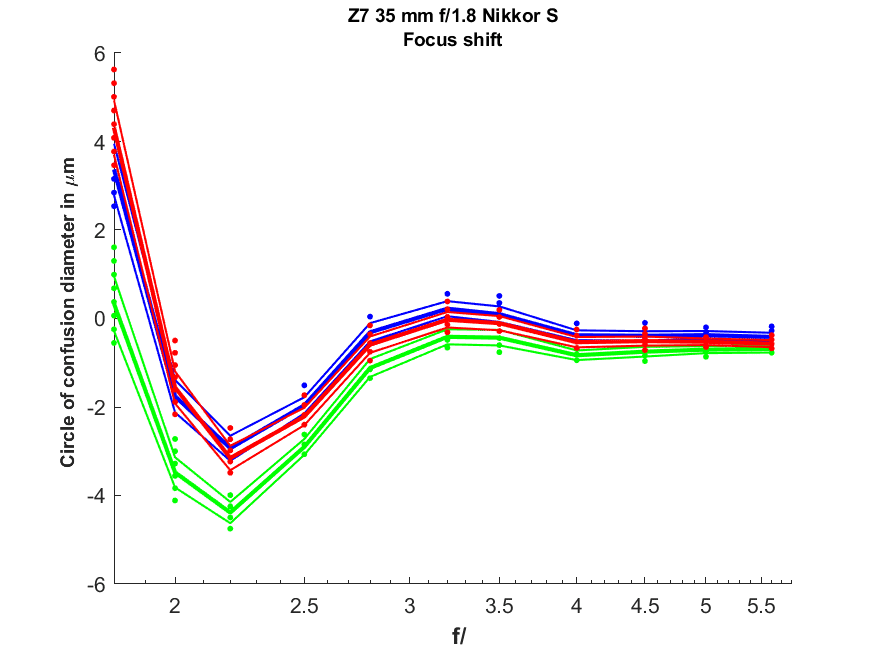This is one in a series of posts on the Nikon Z7. You should be able to find all the posts about that camera in the Category List on the right sidebar, below the Articles widget. There’s a drop-down menu there that you can use to get to all the posts in this series; just look for “Nikon Z6/7”.
There have been reports of large amounts of focus shift with the 35 mm f/1.8 Nikkor S on the Nikon Z7. Several people have asked me to take a look. I finally got around to doing the tests, and here’s what I found.
I made 32 images at 55 cm at each aperture, starting wide open and proceeding in one-third stop steps until f/5.6. Plotted above as dots are the image field (sensor plane) focussed distances for all the samples for each of the Adobe RGB color planes. The difference between the three color planes is a measure of longitudinal chromatic aberration (LoCA). The distances are measured from the average of the green plane samples with the lens wide open. Backfocusing is indicated by positive numbers and front focus by negative ones. The heavy lines are the average of all 32 samples at each aperture, and the lighter ones are plus and minus one standard deviation away from that.
You can see that this lens has moderate LoCA wide open and that the LoCA diminished substantially by f/2.5.
To see the effect on photographs, it’s better to look at the diameters of the circles of confusion (CoCs) implied by the above displacements of the image plane.
The pixel pitch of the Z7 is a bit over 4 micrometers (um). This is not severe focus shift.
Looking at the big picture, I don’t see why even much greater focus shift would be a problem for the Z7 since it focuses at the taking aperture at all f-stops wider than f/6.3.
It is possible that the lens could have greater focus shift at longer subject distances. I don’t have a good way to test focus shift for wide lenses at other than close distances.


Jim, to show my possible naivete’- I presume all the test are autofocus tests? If so, why do non action photos need auto focus? One of the reasons I quit Nikon some years ago was the calibrating, electronically, of the various lenses on the D800E’s that I had.
Electronic screens show exactly what you are shooting with a manual lens, far as I know?
So if you have say a good Zeiss or Voigtlander or Leica lens, if the EVF shows it in focus, problem solved, ?
Am I missing something? It has been a long time since I was an engineer on the Apollo project, but unless Alzheimers is upon me, I don’t see the need for auto focus.
The focus shift test is a manual focus test. Focus the lens on the target wide open, and measure the shift in the position of the focal plane as you stop down. I have done AF tests of the 24-70/4 Nikkor S, and you can find them here:
https://blog.kasson.com/nikon-z6-7/af-s-and-afc-accuracy-24-70-4-nikkor-s-on-z7-at-70-mm/
https://blog.kasson.com/nikon-z6-7/af-s-and-afc-accuracy-24-70-4-nikkor-s-on-z7-at-35-mm/
If you focus at taking aperture, then focus shift is not a problem. If you focus wide open and stop down before making the exposure, it can be.